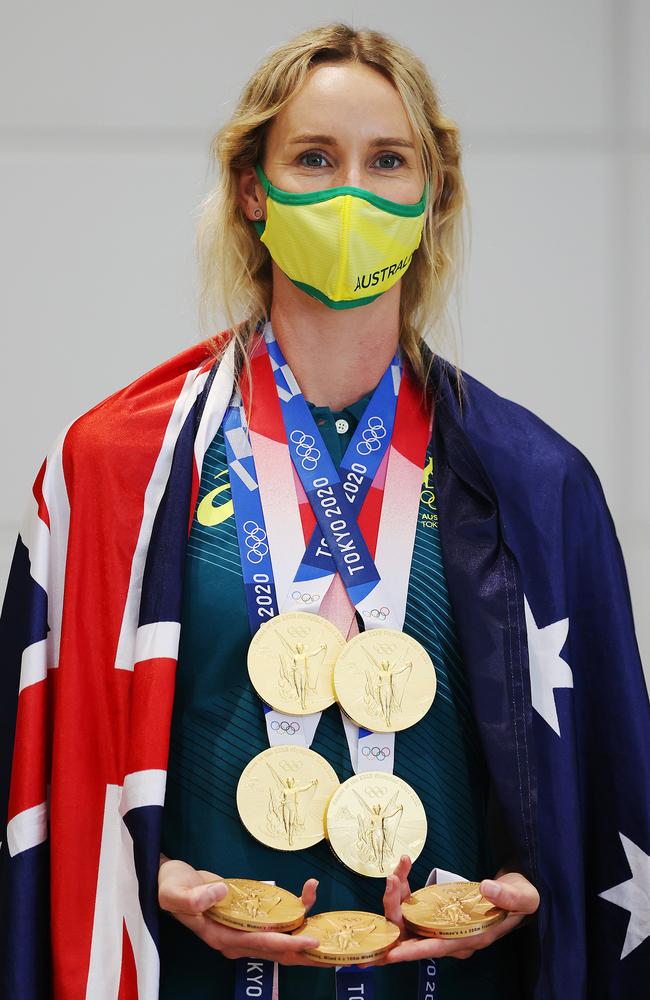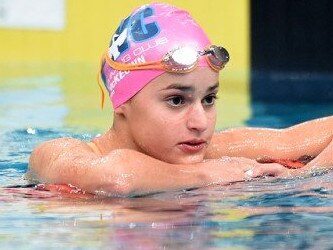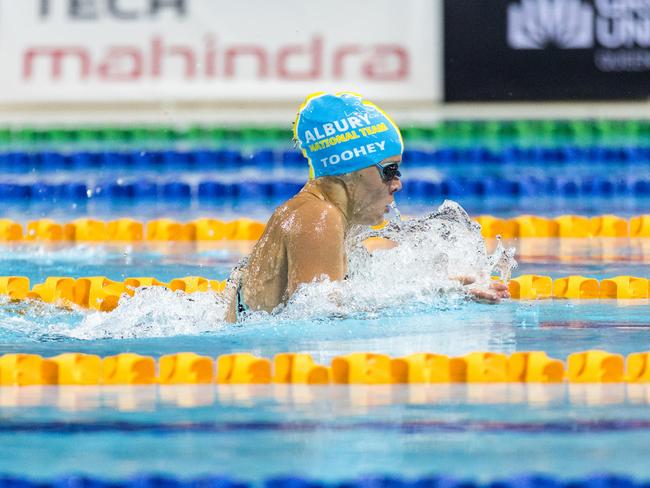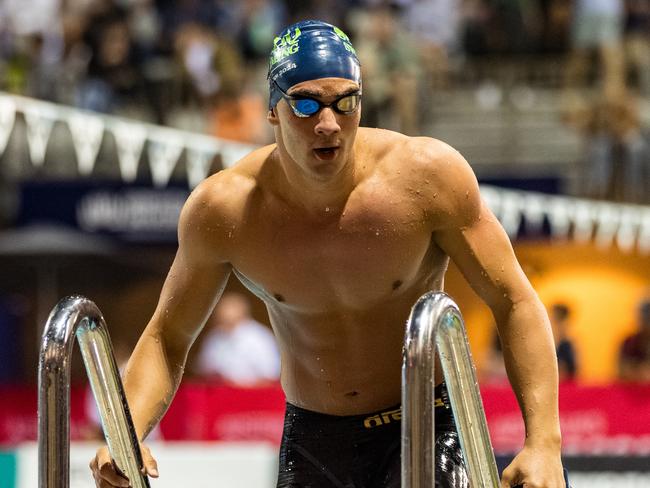Australia’s next generation of Olympic swimming hopes as golden age cliff looms
Australia is enjoying arguably the greatest golden generation in its swimming history, but can the next wave of stars carry the Dolphins to Los Angeles 2028 and the Brisbane 2032 games?

Brisbane Olympics 2032
Don't miss out on the headlines from Brisbane Olympics 2032. Followed categories will be added to My News.
As Australia prepares for an Olympics with perhaps the greatest golden generation in swimming history, the search is on for the next wave of stars to carry the Dolphins to the Los Angeles 2028 and Brisbane 2032 Games.
History proves that Australian swimming can regenerate talent, yet the key is to avoid the plunge in performance that followed the last Olympic peak.
Sydney 2000 (five gold medals) was the start of a golden run for Australia that apexed in Athens with seven gold and carried into Beijing 2008, with six gold led by Stephanie Rice.
But the freefall to London (one gold medal, 10 total) was swift and brutal.
The Rio return (three gold) was only marginally better, before the stunning recalibration that reaped a record nine golds in Tokyo.
Paris this year may be even stronger.
So, when will it end?
And if Australia is currently riding the crest with the likes of Kaylee McKeown, Ariarne Titmus, Mollie O’Callaghan and Emma McKeon, can its emerging talent prevent a sharp downturn?
McKeown and O’Callaghan will likely still be swimming in LA, but McKeon will retire after Paris and there remains uncertainty over how long Titmus can put her body through the intense workload of middle distance swimming.
Now is the time to start to identify the next generation, but coaches know true gems are hard to find.
“Household names are one in a million, probably greater really,” says Simon Cusack, the coach now charged with youth development in Australian swimming; best known for turning the Campbell sisters – Cate and Bronte – into multiple world champions.
“I remember when Emily Seebohm and Cate Campbell started poking their heads through at 14. They are special athletes.
“Someone like Bronte didn’t win her first national age (title) until she was about 16.
“They don’t come along that often, they are a rare thing and a real diamond.
“I hate to label kids as being the next best thing, if we google it we generally find names that never made it. They were just ahead of their time or they developed earlier than the rest of the fields.
“But we always look forward to the next best thing.”

Former world champion James Magnussen said it was a credit to the coaching staff that had nurtured this once in a generation swim team – but it was important ongoing success was not taken for granted.
“This is a generational team,” Magnussen said.
“Do not take this team for granted. Savour this Olympics.
“Enjoy this meet in Paris because we have a propensity when this happens ala Sydney into Athens and Beijing, we have a propensity to just come to expect that and it’s not normal to have this many good swimmers at the one time.
“We have the best swimmers in the world, some of the best swimmers in history right now and it’s kind of going unnoticed.”
*****
The Australian Age championships, held on the Gold Coast earlier this month, are the breeding ground of future success.
Hundreds of athletes converged to chase medals and selection into youth teams, with opportunities to compete overseas or win invitations to various training camps staged throughout the year.

Cusack and Gary Barclay, the General Manager of Performance Pathways, watched over the meet with a close eye.
The results, they say, were promising.
“If I go back 12 months, that was my first national Age since about 2011, it was interesting coming back into youth land,” Cusack says.
“The difference last year and this year was clear, those states affected by Covid are really getting back on their feet.
“States like Victoria in particular had the straw knocked out of it really with those shutdowns.
“(Now) the spread of medals across the nation is also very promising. We are putting a lot of energy into working with coaches across all states with our leadership team.
“That is starting to come to fruition now.
“It is less about one particular state being all-powerful, which I think is good for the country going forward.”
The beauty, and perhaps danger, in swimming is that the clock never lies.
Comparisons come easily when records and top 10 performances all-time are kept for every age group.
The Dolphins’ biggest current stars – those breaking world records, winning world titles and contending for Olympic gold medals – nearly all have a national age record to their name.
McKeown, the Tokyo triple gold medallist, still holds 11 records ranging from the 13 to 18-year age groups.

Kyle Chalmers, an Olympic gold and silver 100m freestyle medallist, still has 10 age records spanning all the age groups.
The list goes on. Titmus has seven records, starting at 16 years old, while O’Callaghan boasts four records, beginning from the same age.
Yet Australia’s greatest Olympian, McKeon, has none.
World champion 400m freestylers Elijah Winnington and Sam Short are also absent from the junior age record books.
That proves Cusack’s point about the folly of trying to find the “next big thing”.
Every athlete develops at different stages of life and in the past, swimming has been too quick to churn and burn teenagers while looking for the next champion.
At this year’s Age championships, not a single record was broken, yet there were eye-catching performances.
Albury breaststroker Sienna Toohey’s 100m time of 1:07.72 made her just the second 15-year-old in Australian swimming history to break 1:08.
The other: Leisel Jones.

Toohey’s time would’ve secured selection on last year’s world titles team and with Olympic trials just seven weeks away, she is one to keep an eye on.
Not that Cusack or the coaches at Swimming Australia are looking that far ahead.
“We’ve had breaststrokers historically, female breaststrokers, have often come through relatively early. It doesn’t always mean they are going to go on,” Cusack says.
“It’s just a unique stroke and they’re at that stage of life where they are going through stages as well. Growth, puberty, all that sort of stuff.
“Often we don’t know until they get out the other side of that and everything solidifies what stroke they will actually be good at in the long run, but it’s certainly promising at this stage … but I wouldn’t be counting my chickens before they hatch.”
*****
At Somerville House swimming club in South Brisbane, Cameron McEvoy is leading a sprint freestyle revolution.
At 29, this is his second coming after going into the 2016 Rio Olympics as the man to beat in the 100m freestyle, before finishing seventh behind shock teenage gold medallist Chalmers.
McEvoy left swimming after the Tokyo Olympics, travelling the world for a year before returning with a new vision of his way forward.
He stacked on muscle, focused his training on dry land performance and reduced his time in the water.
McEvoy studied Usain Bolt and in particular, how athletics sprinters prepare for the 200m. Applying those lessons and working with coach Tim Lane, he produced an astonishing 50m freestyle win at last year’s world titles, capturing worldwide attention with the revolutionary approach.
The ideology change has not just refuelled McEvoy’s passion for the sport, it’s extended his career to the point where he believes that he will race until Brisbane 2032, at age 38.
At the other end of the journey is 16-year-old stablemate Josh Conias, who won 50m gold at the Age titles in 22.35; just 0.02 off Chalmers’ record.

Conias made the national open titles final a week later, a boy among men in a race dominated by power athletes.
Paris may be a year too soon but he’s tracking to challenge McEvoy and the world.
“Yeah, it’s promising,” Cusack says.
“He is in a program where they specialise in sprint swimming under a good coach.
“He is learning off one of the best in that coach and professor Cam.
“It’s great we’ve got programs that are very sprint-oriented.
“We are trying to cater for everyone, rather than a cookie cutter approach, we try to have a lot of diversity within our training; both in coaching personalities and event targeting, so we can cater for all talent.”
*****
The biggest race of Australia’s 2024 Olympic trials will be the women’s 100m freestyle, featuring six of the 12 fastest women in history.
Not even the Olympic final in Paris will boast such prestigious depth.
Reigning world champion O’Callaghan will be favourite, while reigning Olympic champion McKeon will battle stars like Shayna Jack, Meg Harris and Brianna Throssell, plus former world champions Cate and Bronte Campbell, pushing for a final Olympic team.
Yet two 17-year-olds may seriously surprise come June.
Bond University swim club’s Milla Jansen was seventh at the national opens in 54.03, while the Carlile club’s Olivia Wunsch won the world junior title last year in 53.71, then the Age title in 53.99.
They are the third and fourth-fastest 17 year olds in Australian history, behind only Cate Campbell (53.03) and O’Callaghan (53.08), and it wouldn’t surprise to see either teen sneak onto the Paris team with a top-six finish at the Olympic trials.
Wunsch is already in the Swimming Australia pathways system and was selected for the Junior Pan Pacs meet, in Canberra during August.
Here are some fellow rising stars to watch after the Age titles.
Not all were selected for the 40-strong Junior Pan Pacs team, with Sheridan and Dunn too young; they headline the wave more likely for Brisbane than Los Angeles.
Cusack says the current priority for those early-teen swimmers and their coaches should not be outright performance.
“At that age, their coaches needed to really concentrate on giving a good base of technique,” he says.
“From there, we can overlay training. High-performance coaches are experts at that. We can overlay speed and endurance
“But if kids don’t start off with great technical skills in all four strokes, it is very hard to fix that as they get older.
“After they’ve done 10 million repetitions, it is very hard to change a stroke pattern.”
More Coverage
Originally published as Australia’s next generation of Olympic swimming hopes as golden age cliff looms




